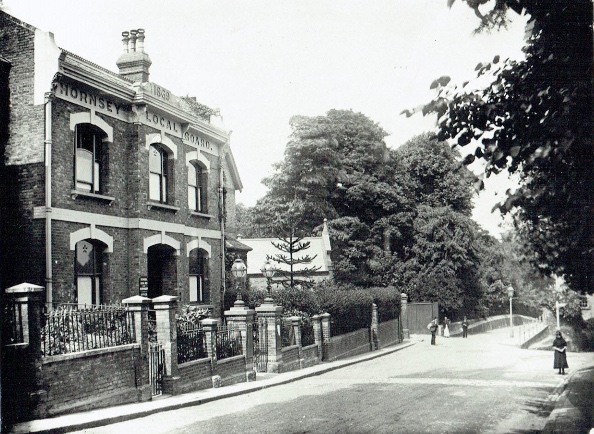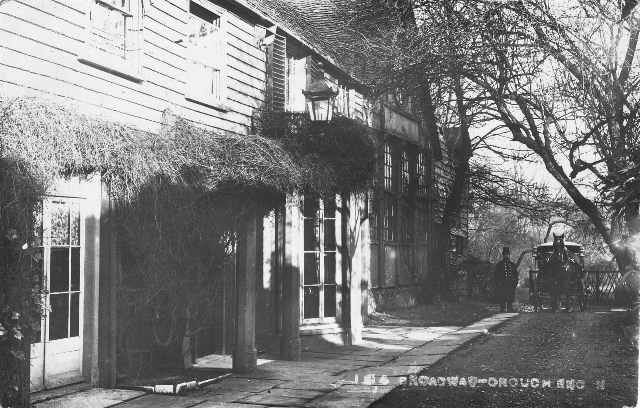
The iconic Art Deco Hornsey Town Hall in Crouch End opened at the end of 1935. Yet the Hornsey Journal, 19 September 1919, refers to town hall plans on this site then. Why did it take so long to realise these ambitions? Where was the original town hall and why did that building and its location have to change?
Different buildings for changing circumstances
The history of local government in the borough of Hornsey goes hand in hand with national developments and with the burgeoning population of the district. Those tasked with managing the district’s affairs at different periods of history needed a building to meet in.
The Parish Vestry 1536 – c.1835
The only local administrative unit for hundreds of years was the parish which from the 16th century onwards took on an important civic function. The poor lost a major source of support following Henry VIII’s Dissolution of the Monasteries. From 1536 onwards, legislation established the principle that they must receive public support through the collection of parish rates.
The Old Poor Law system (1601) was operated by the parish clergy and respected, unpaid, members of the community. They constituted the Vestry and had other functions, for example, maintaining the parish highways. A Parish Clerk kept minutes of meetings. Hornsey parish was very large so was divided administratively into ‘Hornsey Side’ and ‘Highgate Side’.
Most of the Hornsey Vestry meetings took place in the vestry room of St Mary’s Church. Occasionally a room at a local inn was used. No particular day was set aside for meetings although Sundays predominated. Sometimes committees were formed to consider specific matters and these quite frequently met in ‘The Three Compasses’ in Hornsey High Street.
The Highways Board c. 1835 – 1867
During the 19th century, starting with the 1834 changes in Poor Law administration, civil administration began to change, reflecting enormous national and local changes in population, housing and the social issues of an industrial nation. Following the Highways Act,1835, a Highways Board was established for Hornsey and twenty Surveyors were appointed.
This Board was reorganized in 1855 with twelve members, including a salaried clerk, a rate collector, an assistant surveyor and a public health inspector, with responsibilities for paving, cleaning and lighting. Drainage and sanitation were major problems as many houses were poorly constructed and lacked any form of sanitation. The Board met 33 times in 1854-5. It had a room at No.17 Highgate High Street and in 1862 one above the pharmacy and Post Office in Highgate. For a short time during the mid-19th century it met at Broadway Hall in Crouch End Broadway.
Hornsey Local Board (of Health) 1867 – 1894
Problems over the appallingly bad sewage system brought the Highways Board to an end. Hornsey adopted the 1858 Local Government Act, setting up a Local Board of Health with 15 elected members who met fortnightly in the Highways Board office in Highgate High Street.
This Board employed a salaried Clerk, Treasurer, Surveyor & Inspector of Nuisances and a Rate Collector. Three committees were set up – Roads & Works; Nuisances, Removal, Sewers & Water Supply, and Finance. Knowing that they needed bigger premises, the Board asked to rent Cromwell House on Highgate Hill but the owner demanded a 21-year lease at £230 p.a. forcing the Board to remain where it was.
In May 1869 the Local Board moved to No.99 Southwood Lane, Highgate, to offices specially constructed on land leased from the London Diocesan Penitentiary nearby. This was a good move. Southwood Lane was a main thoroughfare from Highgate to all other parts of Hornsey parish and accessible to the railway stations in Hornsey (1850) and Crouch End (1867).

Legislation increased the Board’s powers. A Planning Committee was added in 1871. Subsequently, in early 1873 a Medical Officer of Health was appointed. For a few years after its formation in 1875, Hornsey School Board also met in the Southwood Lane offices. The offices were greatly enlarged in 1885 to cope with the amount of work required. Appalling sanitary conditions, dismal lighting and unusable roads dominated Board business for years.
Hornsey Urban District Council 1894 – 1903
Henry Reader Williams was a councillor from 1873 and Chairman of the Board from 1884, whose energetic involvement in, and influence over the Local Board’s increasing responsibilities, made him the ‘Father of Hornsey,’ and led to Hornsey being dubbed ‘Healthy Hornsey’. He retired in 1894 just as Hornsey’s administration entered a new phase as an Urban District.
Henry Burt JP took over Williams’s mantle as the energetic councillor who made things happen. He secured the purchase of Alexandra Palace, campaigned ceaselessly for public libraries and promoted electricity as an alternative to coal gas. The office buildings at No.99 Southwood Lane were by now totally unsuitable for a local administration with a continuing expansion of responsibilities.
Hornsey Borough Council 1903 – 1935 move to new premises
In 1903 the offices in Southwood Lane were enlarged again and once more in 1916. As the Hornsey Journal points out, various committees had sought accommodation wherever they could. Action was suddenly taken in September 1919 on the death of Dr. Loraine Orton, the son of Dr Frederick Orton, a much respected Crouch End resident who had died in 1917.

The Orton estate was put on the market and comprised Nos.16, 18, 22 (Lake Villa) and 24 The Broadway and Broadway Hall. The Council’s Works Committee acted promptly and by the end of October 1919 were negotiating the purchase of the Orton estate for £4,625. It had insufficient land on which to build a town hall worthy of Hornsey. However, not all councillors agreed with the purchase. Thoughts of a fine town hall for Hornsey were shelved. Further land was acquired in 1920 and 1923 which was laid out as a public park. These were difficult times financially, both for Hornsey and the nation, culminating in the Wall Street Crash of 1929. The grand scheme for a new Hornsey Town Hall eventually got underway in the early 1930s.
Image credits
Hornsey Historical Society
Further reading
For detailed information on Hornsey Town Hall and its surrounding buildings read Civic Pride In Hornsey, by Bridget Cherry, Hornsey Historical Society, 2006.